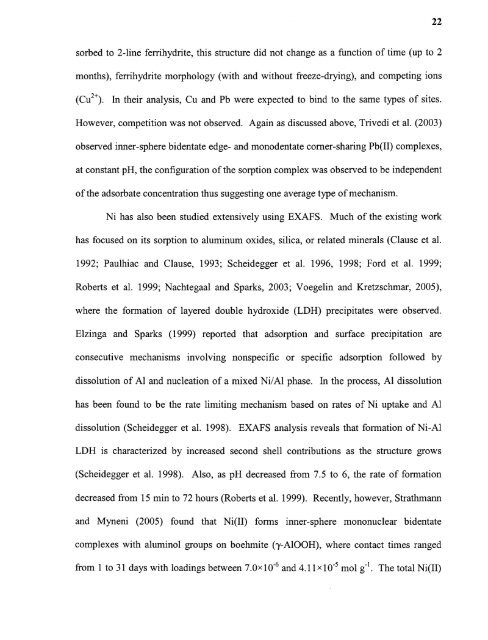Heavy metal adsorption on iron oxide and iron oxide-coated silica ...
Heavy metal adsorption on iron oxide and iron oxide-coated silica ...
Heavy metal adsorption on iron oxide and iron oxide-coated silica ...
You also want an ePaper? Increase the reach of your titles
YUMPU automatically turns print PDFs into web optimized ePapers that Google loves.
22sorbed to 2-line ferrihydrite, this structure did not change as a functi<strong>on</strong> of time (up to 2m<strong>on</strong>ths), ferrihydrite morphology (with <strong>and</strong> without freeze-drying), <strong>and</strong> competing i<strong>on</strong>s(Cu2±). In their analysis, Cu <strong>and</strong> Pb were expected to bind to the same types of sites.However, competiti<strong>on</strong> was not observed. Again as discussed above, Trivedi et al. (2003)observed inner-sphere bidentate edge- <strong>and</strong> m<strong>on</strong>odentate corner-sharing Pb(II) complexes,at c<strong>on</strong>stant pH, the c<strong>on</strong>figurati<strong>on</strong> of the sorpti<strong>on</strong> complex was observed to be independentof the adsorbate c<strong>on</strong>centrati<strong>on</strong> thus suggesting <strong>on</strong>e average type of mechanism.Ni has also been studied extensively using EXAFS. Much of the existing workhas focused <strong>on</strong> its sorpti<strong>on</strong> to aluminum <strong>oxide</strong>s, <strong>silica</strong>, or related minerals (Clause et al.1992; Paulhiac <strong>and</strong> Clause, 1993; Scheidegger et al. 1996, 1998; Ford et al. 1999;Roberts et al. 1999; Nachtegaal <strong>and</strong> Sparks, 2003; Voegelin <strong>and</strong> Kretzschmar, 2005),where the formati<strong>on</strong> of layered double hydr<strong>oxide</strong> (LDH) precipitates were observed.Elzinga <strong>and</strong> Sparks (1999) reported that <str<strong>on</strong>g>adsorpti<strong>on</strong></str<strong>on</strong>g> <strong>and</strong> surface precipitati<strong>on</strong> arec<strong>on</strong>secutive mechanisms involving n<strong>on</strong>specific or specific <str<strong>on</strong>g>adsorpti<strong>on</strong></str<strong>on</strong>g> followed bydissoluti<strong>on</strong> of Al <strong>and</strong> nucleati<strong>on</strong> of a mixed Ni/Al phase. In the process, Al dissoluti<strong>on</strong>has been found to be the rate limiting mechanism based <strong>on</strong> rates of Ni uptake <strong>and</strong> Aldissoluti<strong>on</strong> (Scheidegger et al. 1998). EXAFS analysis reveals that formati<strong>on</strong> of Ni-AlLDH is characterized by increased sec<strong>on</strong>d shell c<strong>on</strong>tributi<strong>on</strong>s as the structure grows(Scheidegger et al. 1998). Also, as pH decreased from 7.5 to 6, the rate of formati<strong>on</strong>decreased from 15 min to 72 hours (Roberts et al. 1999). Recently, however, Strathmann<strong>and</strong> Myneni (2005) found that Ni(II) forms inner-sphere m<strong>on</strong><strong>on</strong>uclear bidentatecomplexes with aluminol groups <strong>on</strong> boehmite (y-A1OOH), where c<strong>on</strong>tact times rangedfrom 1 to 31 days with loadings between 7.0x10 -6 <strong>and</strong> 4.11x10 -5 mol g-1 . The total Ni(II)
















